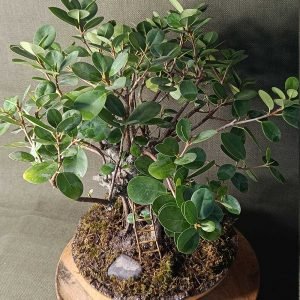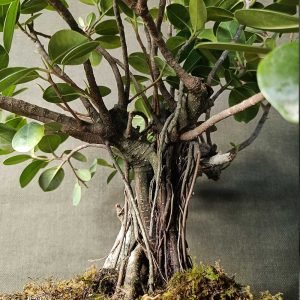Ficus microcarpa bonsai Leave a comment
Ficus microcarpa : Bonsai have long been respected in the ancient art of Feng Shui for their ability to draw life energies into a room. As a focus of sight, conversation, and living forces, a Bonsai can quickly spread joy and contentment to all who see it. Ficus microcarpa is commonly known as Chinese banyan, Malayan banyan, Indian laurel, Glossy-leaf Fig.
Ficus Microcarpa Specifications
| Plant type | Shrub tree |
| Family | Moraceae |
| Native | Southeast China, Japan, Philippines, Taiwan, Indonesia, North Australia |
| Difficulty Level of cultivation | Beginner-friendly |
| Size | Indoors not more than 1.5 m Outdoors up to 25 m high. |
| Growth rate | Moderate |
| Lifespan | Perennial |
| Temperature | In the summer: 18-23°C, in winter, not below 16°C. |
| Bloom | Small round blossoms of purple colour about 2 cm in size, similar to berries. |
| Soil | Indoor plant soil mix, well-drained |
| Sunlight Exposure | Indirect but luminous |
| Foliage | Evergreen |
| Watering | Moderate |
Ficus microcarpa bonsai is a beautiful indoor plant. It is native in a range from China through tropical Asia and the Caroline Islands to Australia. Belonging to Moraceae (Mulberry) family. Commonly known as Chinese banyan, Malayan banyan, Indian laurel, Glossy-leaf Fig.

Medicinal /Therapeutic Uses
The plant is also used in traditional medicine in India, Malaysia, China and Japan.
-
Bark,aerial roots and dried leaves are traditionally used against pain and fever, flu,malaria, bronchitis, liver disease, burning sensations and rheumatism.
-
Pharmacological properties include antioxidant activities, anti-bacterial, anti-carcinogen and anti-diabetic agents.
A Ficus microcarpa bonsai is an amazing choice for the plant lovers as it is beginner-friendly, beautiful and easy to maintain.
Caring of Ficus microcarpa
Temperature
As, Ficus Microcarpa is a tropical plant, and it is familiar with warm humid conditions. Temperatures hovering around 60 to 70 or 75°F (15 to 25°C) are perfect year round. As they flourish well in warm temperatures, Place them in an area that receives plenty of bright, indirect light. It makes them ideal for shaded areas, such as a patio (a flat, hard area, usually behind a house, where people can sit outside) with a cover. Bring them back in when the temperature drops below 60 degrees.


Lighting
-
A lot of light will help, but not direct sunlight during hotter hours. Indirect light is best.
-
When picking an ideal location for bonsai, an east-facing window is the best. As, it receives a lot of brilliant morning light, and not too much resulting in the perfect atmosphere.
-
One can also opt for south and west-facing windows because they provide abundant natural light.
-
Gusts of wind and drafts will lead to leaves falling off: keep it protected and out of corridors and hallways.
Soiling
Any garden soil mix will suffice as long as it is well-draining.
Fertilizer
Liquid fertilizer, alternating organic and mineral can be used. During the growing season, bonsai trees should be fed weekly with bonsai fertilizer. Bonsai may stop absorbing nutrients during late summer and early fall. As the growth of bonsai begins to slow down, reduce feeding to only once a month.
Watering Ficus microcarpa naturally thrives in moist, humid climates.
Watering (In Summers)
-
Stick a fingertip in the soil down to the first knuckle, and if it still feels moist, don’t water yet.
-
Depending on the dryness of the air, this could be once every three to four days up to every ten days.
-
Don’t let water collect around the roots. Let it drip until dry before putting it back on its saucer.
Watering (In Winters)
Growth and vegetation slows down in winters. So it needs less water.
-
Water at most once a fortnight.
-
Don’t use cold water straight from the tap. Pour some in a quart or jug and set it near the pot for a few hours with the cap open. This will help vent out any chlorine and raise the temperature to avoid thermal shock to the plant.
Pruning and trimming
Ficus microcarpa can grow huge in the wild in tropical climates, but in the house one want it to remain a smallish bonsai for best effect. Ficus microcarpa has the capacity to sprout new sprigs directly from the bark of the trunk.
There are two ways of keeping your Ficus microcarpa under control.
Constant pruning means checking on the plant often and removing twigs and growth that doesn’t please you.
-
Every time you count up to ten new leaves, cut sprigs back, removing four to six new leaves in the process.
-
This will force the Ficus microcarpa to produce new twigs and leaves.
-
Try to balance growth to keep the plant covered all around, like an umbrella atop the root trunk.
-
Rotate the plant to even growth out every time you prune.
-
Only prune as leaves grow. If the plant isn’t making new leaves, don’t prune.
Seasonal pruning means only checking on the plant once or twice a year. Pruning is heavier.
-
During Spring season
-
Cut branches back by a third or even half.
-
If you don’t like the shoots that may be sprouting from below the graft joint, cut them off as entirely.
-
Feel free to defoliate (or remove the leaves) upon pruning. New leaves will grow back.
Transplantation/Repotting- Repotting ensures that nutrients in the soil are replenished. It is also a way to monitor root growth and check that the potting mix isn’t rotting wet. Remove roots growing through drainage holes to ensure water flows freely.
Repotting of Ficus microcarpa is essential, every one to three years.
-
Once a year is perfect, and it can be paired with trimming, defoliating and pruning to slowly create a majestic, elegant bonsai.
-
Ensure excellent drainage (drainage layer made with clay pebbles or gravel, drainage hole under the pot, clean sand in the soil mix).
Plant Protection
Pests – Pests that attack Ficus microcarpa are common houseplant pests: Spider mites, whiteflies, aphids, shields, thrips, and scale insect.
Diseases – If bonsai encounters these diseases, immediate steps should be taken for the care of ficus microcarpa.
-
Ficus microcarpa leaves brittle and falling off – not enough watering or too much wind in that spot.
-
Ficus microcarpa leaves turning yellow and falling off – too much watering and/or poor drainage. Let soil dry before watering again, check drainage, and add sand or cactus soil mix to the potting soil.
Cleaning and Misting (leaves)
Bring Ficus microcarpa to the sink and gently spray soft water on its leaves from time to time.
-
Use a soft square of cloth (preferably cotton) to remove dust and traces of insects from time to time.
-
A good size cloth is a square as wide as your hand.
-
Wrap the cloth around the hand with your fingers so the falling tips won’t catch on branches.
Types of Pot
-
A pot made up of ceramic or porcelain, and that it is stoneware burned, which means that it absorbs and holds no water in the material is the ideal for potting Ficus microcarpa bonsai.
-
The size of the pot according to the general rule of thumb is that the pots depth should be equal to the diameter of the trunk just above soil level. For oval or rectangular pots, the length of the pot should be 2/3 the height of the tree. For round pots, the diameter of the pot should be 1/3 the height of the tree.
Don’ts
-
Ficus microcarpa plant care involves avoiding the shady or dark areas for placement. It will not be able to thrive well in such conditions.
-
Tap water is not the best idea for your plant to drink as it contains chemicals and minerals. You should use soft water, which is low in chemicals and minerals, filtered or distilled water.
-
Note for ficus microcarpa plant care: Make sure not to feed your bonsai when it is sick.
* Ficus Microcarpa thrives well in warm and humid conditions. The ficus microcarpa plant care is beginner-friendly, and anyone can grow this bonsai at home. All you have to do is be a little cautious while watering and pruning.
As a gift, it’s a perfect choice. It will light a green lamp in the house.


